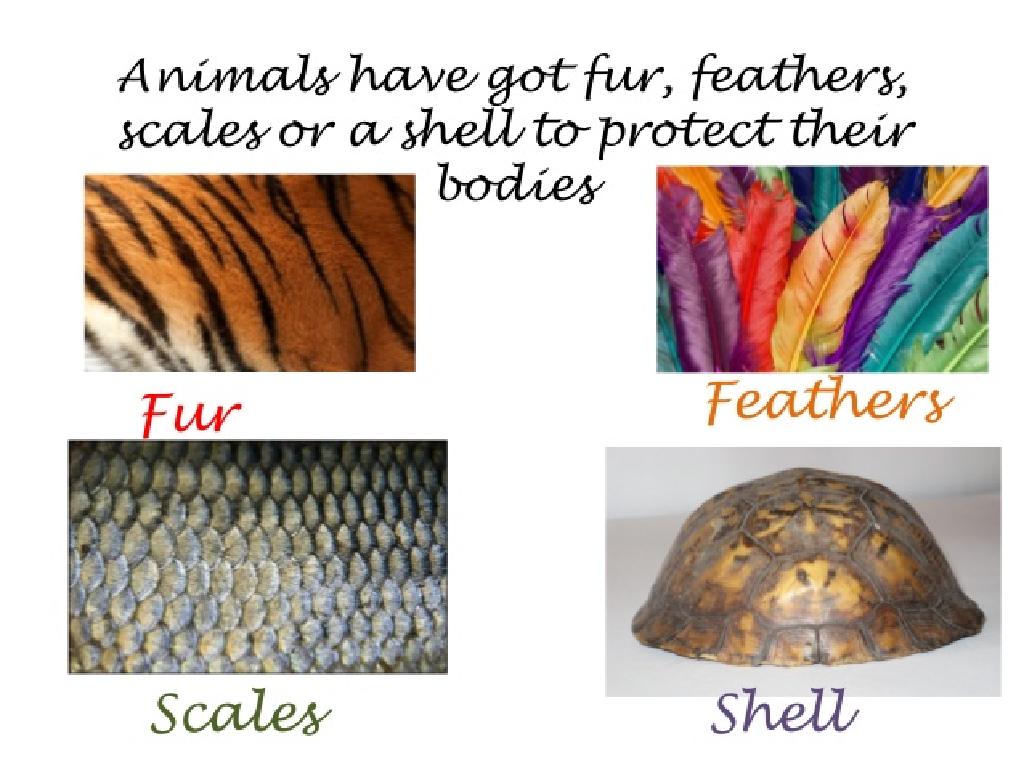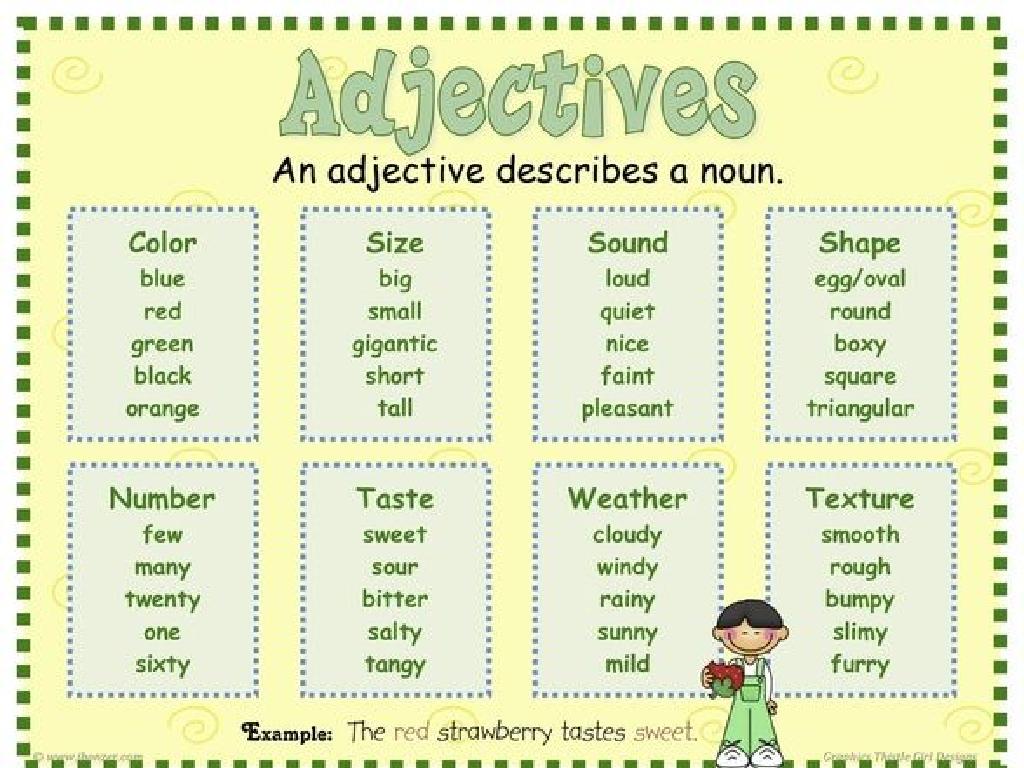Select Parts Of Water Cycle Diagrams
Subject: Science
Grade: Seventh grade
Topic: Water Cycle
Please LOG IN to download the presentation. Access is available to registered users only.
View More Content
Welcome to the Water Cycle!
– Journey of water on Earth
– Water travels through various stages: evaporation, condensation, precipitation, and collection.
– Water cycle’s role in sustaining life
– The cycle provides fresh water, regulates climate, and supports ecosystems.
– Exploring water cycle diagrams
– Diagrams help visualize the stages and processes of the water cycle.
– Importance of each cycle part
– Understanding each part helps grasp the cycle’s complexity and significance.
|
This slide introduces the concept of the water cycle and its significance to life on Earth. Students will learn how water continuously moves through different stages, including evaporation, condensation, precipitation, and collection, and how this cycle is crucial for providing fresh water and maintaining ecological balance. The lesson will focus on dissecting water cycle diagrams to understand each part’s role and importance. Encourage students to think about how the water cycle affects their daily lives and the environment. This foundational knowledge sets the stage for more in-depth exploration of each stage in subsequent lessons.
Exploring the Water Cycle
– Define the Water Cycle
– The water cycle is Earth’s way of recycling water.
– Water’s Continuous Journey
– Water travels from Earth to the air and back again.
– Four Main Stages
– Evaporation, Condensation, Precipitation, Collection.
– Cycle’s Role in Nature
– Supports ecosystems and regulates climate.
|
The water cycle is a continuous process that recycles Earth’s water supply. It’s essential for students to understand that the water cycle is nature’s way of purifying and distributing water across the planet. The four main stages evaporation, condensation, precipitation, and collection work together to maintain this cycle. Evaporation turns water into vapor, condensation forms clouds, precipitation returns water to Earth, and collection gathers it into bodies of water. Emphasize the importance of each stage and how they contribute to sustaining life on Earth. Discuss how the water cycle affects weather patterns and the environment. Encourage students to think of questions or examples of how they experience the water cycle in their daily lives.
The Water Cycle: Evaporation
– Sun heats water: turns to vapor
– Evaporation: oceans, lakes, rivers
– Observe evaporation: wet cloth
– Place a wet cloth outside, watch it dry
– Evaporation’s role in water cycle
– Evaporation starts the cycle, leading to condensation and precipitation
|
Evaporation is a key process in the water cycle, driven by the sun’s heat. It involves the transformation of water from liquid to gas. Most evaporation occurs from the surface of large bodies of water, including oceans, lakes, and rivers. To help students understand this concept, an activity can be conducted where they observe a wet cloth drying in the sun, which simulates evaporation on a smaller scale. Discuss the importance of evaporation in the water cycle, emphasizing its role as the initial step that leads to condensation and precipitation. This will help students grasp the continuous and cyclical nature of the water cycle.
Understanding Condensation
– Water vapor cools down
– Formation of clouds
– Clouds form when water vapor condenses into tiny droplets.
– Clouds in the water cycle
– Clouds play a crucial role in the water cycle, preparing for precipitation.
– Activity: Mini cloud in a bottle
– Observe condensation by creating a cloud using a plastic bottle.
|
This slide introduces the concept of condensation in the water cycle, focusing on how water vapor cools and forms clouds. Begin by explaining that when water vapor in the air cools down, it changes back into liquid form, creating clouds. Emphasize the importance of clouds in the water cycle as they are the source of precipitation. For the class activity, guide students to create a mini cloud in a bottle to visualize condensation. This can be done by compressing air in a plastic bottle with a little bit of water and then releasing the pressure, allowing students to see the formation of a cloud. Provide detailed instructions and ensure safety measures are followed. Discuss the observations and relate them back to the larger water cycle.
Understanding Precipitation in the Water Cycle
– Precipitation: Water returns to Earth
– Rain, snow, sleet, or hail
– Forms of precipitation based on temperature and atmospheric conditions
– Factors affecting precipitation type
– Temperature, humidity, and air pressure play a role
– Discuss local precipitation types
|
This slide focuses on the concept of precipitation, a crucial part of the water cycle where water falls back to Earth in various forms. Students should understand that whether it’s rain, snow, sleet, or hail depends on conditions like temperature and atmospheric pressure. Engage the class in a discussion about the types of precipitation they commonly experience in their locality, which will help them connect the concept to their everyday lives. Encourage them to observe and think about the weather patterns they see and how they fit into the water cycle. This will also be an opportunity to introduce the idea of climate and how different regions experience different types of precipitation.
Collection: Water’s Journey on Earth
– Water collects in various places
– Oceans, rivers, lakes, and underground
– Groundwater and aquifers explained
– Aquifers are underground layers where groundwater is stored
– Activity: Terrain and water collection
– Use sponges to simulate how water gathers in different landscapes
|
This slide introduces the concept of collection in the water cycle, where water accumulates in various natural reservoirs such as oceans, rivers, and lakes, as well as underground in aquifers. Groundwater and aquifers play a crucial role in the water cycle, acting as storage areas that release water slowly over time. The class activity involves using sponges to model how water collects in different terrains, providing a hands-on understanding of the concept. Teachers should prepare sponges of varying textures and sizes to represent different terrains and guide students through the experiment, discussing how terrain affects water collection and movement.
Analyzing the Water Cycle Diagram
– Identify water cycle parts
– Label parts like evaporation, condensation, precipitation, and collection
– Understand stage connections
– How does evaporation lead to condensation and then to precipitation?
– Group activity: draw & label
– In groups, students will create their own diagrams of the water cycle
|
This slide is aimed at helping students understand the water cycle by identifying and labeling its various parts. Begin with a discussion on the main stages: evaporation, condensation, precipitation, and collection. Explain how each stage is connected to the others and the role of the sun in driving the cycle. For the group activity, provide students with the necessary materials to draw and label their own water cycle diagrams. This hands-on activity will reinforce their understanding of the cycle’s stages and the transitions between them. Encourage creativity and ensure each group understands the significance of each part they label. After the activity, facilitate a discussion where groups can present and explain their diagrams to the class.
The Importance of the Water Cycle
– Sustains all Earth’s life forms
– Water cycle is crucial for survival of plants, animals, and humans.
– Regulates climate and weather
– Influences temperature, precipitation, and seasonal changes.
– Provides and renews freshwater
– Continuous movement of water purifies and distributes it across the planet.
– Balances ecosystems and habitats
– Maintains the health of rivers, lakes, and wetlands.
|
This slide emphasizes the critical role of the water cycle in supporting life, regulating climate, and maintaining freshwater resources. It’s essential for students to understand that the water cycle is a natural process that recycles water throughout the Earth’s atmosphere, surface, and underground. It’s not just about rain and evaporation; it’s a complex system that affects every living organism and the environment. Discuss how the water cycle contributes to the stability of ecosystems and how human activities can impact this delicate balance. Encourage students to think about how water reaches their homes and the importance of conservation.
Class Activity: Water Cycle Role Play
– Divide into four groups: Sun, Clouds, Precipitation, Collection
– Act out each part of the water cycle
– Reflect on the role-play experience
– Think about how each part contributes to the water cycle
– Discuss the learning outcomes
– Share insights and clarify any misconceptions
|
This interactive class activity is designed to help students understand the water cycle through role-play. By dividing the class into groups representing different elements of the water cycle, students can physically act out the processes of evaporation, condensation, precipitation, and collection. After the role-play, lead a reflection session where students can discuss their experiences and what they’ve learned. This will help reinforce their understanding of the water cycle’s components and their functions. Possible activities for the groups: Sun group can demonstrate evaporation, Clouds can show condensation, Precipitation can act out rain/snow, and Collection can gather the ‘water’ in different ‘bodies’ like lakes and oceans.


-a-solution-to-the-system-of-equations/introduction_systems_equations.jpg)



